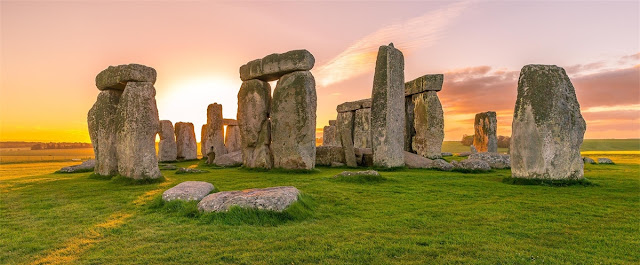Stonehenge
Stonehenge is a megalithic ruin in the Salisbury Plain in southern England. about 128.7 km southwest of London. It is around 5,000 years old.
Stonehenge is not a single structure. It consists of a series of structures made
of earth, timber, and stone. It initially consisted of a circular ditch with a raised bank on the inside. The outer circle and horseshoe of Stonehenge had 30 vertical Sarsen stones (sandstones) and an equal number of horizontal lintels. The 30 lintels rested on top of and connected the 30 upright Sarsen stones. There is another set of blue stones and Trilithons. Trilithons are ill upright stones arranged as live free standing pairs with a single horizontal lintel. There were also four ’station stones’ set in a rectangle outside the ring.
Construction
The construction of Stonehenge was done in three phases. These three phases have been labeled as Stonehenge I, II, and III by Professor Richard Atkinson, a researcher at Stonehenge.
Phase I
The first phase of the construction of Stonehenge dates back to 2950-2900 BC or the Middle Neolithic Age. During this
phase, Stonehenge was a circle of timber posts surrounded by a ditch and bank. The circle had a diameter of 100 m. There were 56 Aubrey holes that held timber posts. The ditch was dug by hand using animal bones. Deer antlers were used as pick-axes to loosen the underlying chalk and shoulder blades of oxen or cattle were used as shovels to clear away the stones.
Phase II
During the second phase, Stonehenge was rebuilt before the arrival of the Romans in Britain. The construction started after 2900 BC and went on for the next 500 years until 2400 BC. This
time blue stones were used to build Stonehenge. These blue stones were brought from the Preseli Mountains in Pembroke, South Wales. They were dragged down to the sea, floated on huge rafts, and brought up River Avon to the Salisbury Plains. The timber posts were no longer there and the Aubrey holes were partially filled.
Phase III
Stonehenge was reconstructed for the third time around 2300 BC. The reconstruction went on until 1600 BC. During this phase, the blue stones were dug up and rearranged and placed in what is known as the Qand R holes. Giant Sarsen stones were hammered to size and placed upright in pairs in a circle. Each pair was connected by lintels. The largest Sarsen was around 7 m in height and weighed more than 44 tons. The Sarsen circle was about 33 m in diameter. During the third phase, a horseshoe-shaped arrangement of five Trilithons was also erected within the Sarsen Circle. They were arranged as five free standing pairs, each with a single horizontal lintel.The tallest Trilithon placed at the center stood about 8 m above the ground and weighed almost 45,000 kg. The lintel placed above it weighed 9,000 kg.’Only three Trilithons with their lintels can be seen now.
Heel stone
The Sarsen Heel stone is a large upright boulder. It IS surrounded by a circular ditch and 18 located along the Avenue. The stone is approximately 4. 88 m in height above the ground. Another 1.22 m In of the stone is buried below the ground.
Mystery
The construction of Stonehenge is still a mystery. There are no records of Why this place was built, dismantled, and rebuilt over the years. Many archaeologists and historians believe that Stonehenge was a sacred ground.
Altar stone
The Altar stone lies embedded in the ground Within the Trilithon Horseshoe. It is a large block of sandstone. There are two other fallen stones across it. The stone is 4. 9 m long and 1 m wide It has a thickness of 0.5 m.








0 comments:
Post a Comment